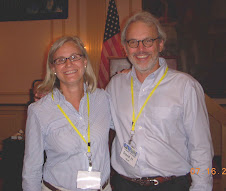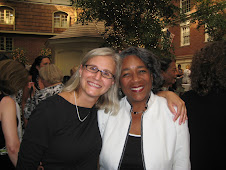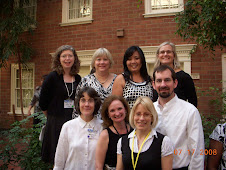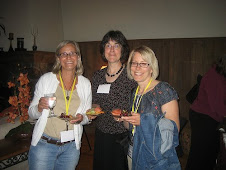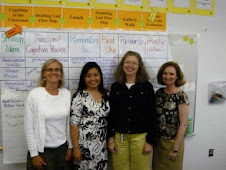Two science teachers recently shared with me some exciting uses of Thinking Maps in their classes.
Mike Roddy used a circle map to activate students' prior knowledge on cycles in his physical universe class. In the circle students defined cycles with synonyms, symbols, ideas and examples of cycles. In the frame they elaborated on why they included ideas. Then Mike used a second color marker and put astronomical in front of cycles, and students added words that defined the new concept astronomical cycles. The students were able to make lots of connections between astronomy and their prior knowledge of the term cycle. After they finished the circle map, Mike pointed out that circle appeared on the definition of cycle, and "isn't it cool that we did a circle map?" The joke bombed. I apologize to Mike because I had made that comment to him earlier when I realized the connection between cycle and circle.
Mark Harelstad has adopted the flow map in his biology class. Not only does he have the unit flow map posted in front of the room to keep his lessons flowing, but also he used a flow map to teach his students about the scientific method. Mark gave them the individual steps of the scientific process, and they had to construct a flow map that indicated the correct order of steps. Now, those steps are posted in the lab on posters, making a big flow map of the scientific method, and students need to follow the same steps for every biology lab.
Thanks science for sharing your stories.
Thursday, September 18, 2008
Thinking Maps for Study Skills
High School 101 is a class designed for sophomores to explicitly teach them the skills necessary to be successful in high school and to improve their English and math skills. One teacher manages the class, contacting teachers and parents for information updates on the students. Other high school teachers work with the students one or two days a week on specialized topics. Two days a week the students work on language arts skills. Two days a week on math skills. And one day a week they work on general study skills.
I designed a unit to be implemented in a series of study skills days, and Doug Eischens, the school social worker, is team-teaching the unit with me.
During the Thinking Maps Unit students move from guiding questions on their lives in general to guiding questions that specifically deal with their academic habits and life as a student. Examining themselves as students will allow them to evaluate their study skills and school habits. The bridge map serves as the bridge between their lives in general and their lives in school.
Each map is presented in this sequence:
Here's the lesson from the first day--
Tree Map
Jackie Teaches the Tree Map:
What was your youth culture like when you were in elementary school? (branches of tree map are recreation, clothing, and family traditions) Frame: Simultaneously jot down stories that go with the items. This map will be used first as a community builder since students will mingle and share their information. All students must share this information but will be told that ahead of time.
Doug Debriefs the Personal Information:
Introduction to the idea that sharing will happen after each map is completed, but students will only be asked to share what they are comfortable sharing. Doug plans to facilitate the after each map debriefs similar to how he runs his student support groups. The students really enjoyed this activity as a way to find out things that they had in common with other students in the room. Doug told them that a support network of friends at school is key, so this sharing of cultural backgrounds really helped that.
Jackie Makes Content Connections and Study Skill Applications:
I wanted to show the students some practical study skill uses for the tree map. I had the students make tree maps for the main character in their English 10 novel in their English notebooks. I have students in two different English classes, so I just did both novels on the white board at once. The English 10 students mapped Codi’s (Animal Dreams) clothes, recreation, and family traditions, and the boys in Guys 10 did the same three branches for Siddhartha. This activity helped students bring the characters to life and allowed them to make personal connections.
Then, I made the students pull out their history notebooks and look at their last lecture notes. I had the students create category titles for a tree map on Mesopotamia--and they came up with religion, literature, and government. They reviewed their notes and synthesized their notes in a tree map. Making a tree map for lecture reflection was hard for them to do, but the product was fascinating.
Stay tuned for future installments of how teaching the other maps goes in High School 101. The circle map is on tap for next week.
I designed a unit to be implemented in a series of study skills days, and Doug Eischens, the school social worker, is team-teaching the unit with me.
During the Thinking Maps Unit students move from guiding questions on their lives in general to guiding questions that specifically deal with their academic habits and life as a student. Examining themselves as students will allow them to evaluate their study skills and school habits. The bridge map serves as the bridge between their lives in general and their lives in school.
Each map is presented in this sequence:
- Students learn the map by making one with personal information.
- Doug debriefs the personal information to blend the students' social/emotional needs with their academic needs.
- Students are taught practical ways to use the map for reading and lecture comprehension with content from their current English 10 course, social studies course, and/or science class.
Here's the lesson from the first day--
Tree Map
Jackie Teaches the Tree Map:
What was your youth culture like when you were in elementary school? (branches of tree map are recreation, clothing, and family traditions) Frame: Simultaneously jot down stories that go with the items. This map will be used first as a community builder since students will mingle and share their information. All students must share this information but will be told that ahead of time.
Doug Debriefs the Personal Information:
Introduction to the idea that sharing will happen after each map is completed, but students will only be asked to share what they are comfortable sharing. Doug plans to facilitate the after each map debriefs similar to how he runs his student support groups. The students really enjoyed this activity as a way to find out things that they had in common with other students in the room. Doug told them that a support network of friends at school is key, so this sharing of cultural backgrounds really helped that.
Jackie Makes Content Connections and Study Skill Applications:
I wanted to show the students some practical study skill uses for the tree map. I had the students make tree maps for the main character in their English 10 novel in their English notebooks. I have students in two different English classes, so I just did both novels on the white board at once. The English 10 students mapped Codi’s (Animal Dreams) clothes, recreation, and family traditions, and the boys in Guys 10 did the same three branches for Siddhartha. This activity helped students bring the characters to life and allowed them to make personal connections.
Then, I made the students pull out their history notebooks and look at their last lecture notes. I had the students create category titles for a tree map on Mesopotamia--and they came up with religion, literature, and government. They reviewed their notes and synthesized their notes in a tree map. Making a tree map for lecture reflection was hard for them to do, but the product was fascinating.
Stay tuned for future installments of how teaching the other maps goes in High School 101. The circle map is on tap for next week.
Friday, September 5, 2008
2008-2009 Cohort Calendar of Events
Thursday, Sept. 25, 2008. Site Visit #1 at EHS. Cohort 5 = 8:00 to 11:00. Cohort 6 = 12:00 to 3:00.
Thursday,October 2, 2008. Site visit #2 at EHS. Cohort 6 = 8:00 to 11:00. Cohort 5 =12:00 to 3:00.
Thursday, October 23, 2008. Cohort 6 has a full-day session off-site with all WMEP schools.
Wednesday, October 29, 2008. Cohort 5 has a full-day session off-site with all WMEP schools.
Wednesday, Nov. 5, 2008. Site Visit # 3 at EHS. Cohort 5 = 8:00 to 11:00. Cohort 6 = 12:00 to 3:00.
Tuesday, February 10, 2009. Site visit # 4 at EHS. Cohort 6 = 8:00 to 11:00. Cohort 5 = 12:00 to 3:00.
Wednesday, February 25, 2009. Cohort 5 has a full-day session off-site with all WMEP schools.
Wednesday, March 4, 2009. Cohort 6 has a full-day session off-site with all WMEP schools.
Thursday, March 19, 2009. Site Visit # 5 at EHS. Cohort 5 = 8:00 to 11:00. Cohort 6 = 12:00 to 3:00.
Tuesday, April 7, 2009. Site visit # 6 at EHS. Cohort 6 = 8:00 to 11:00. Cohort 5 = 12:00 to 3:00.
Thursday,October 2, 2008. Site visit #2 at EHS. Cohort 6 = 8:00 to 11:00. Cohort 5 =12:00 to 3:00.
Thursday, October 23, 2008. Cohort 6 has a full-day session off-site with all WMEP schools.
Wednesday, October 29, 2008. Cohort 5 has a full-day session off-site with all WMEP schools.
Wednesday, Nov. 5, 2008. Site Visit # 3 at EHS. Cohort 5 = 8:00 to 11:00. Cohort 6 = 12:00 to 3:00.
Tuesday, February 10, 2009. Site visit # 4 at EHS. Cohort 6 = 8:00 to 11:00. Cohort 5 = 12:00 to 3:00.
Wednesday, February 25, 2009. Cohort 5 has a full-day session off-site with all WMEP schools.
Wednesday, March 4, 2009. Cohort 6 has a full-day session off-site with all WMEP schools.
Thursday, March 19, 2009. Site Visit # 5 at EHS. Cohort 5 = 8:00 to 11:00. Cohort 6 = 12:00 to 3:00.
Tuesday, April 7, 2009. Site visit # 6 at EHS. Cohort 6 = 8:00 to 11:00. Cohort 5 = 12:00 to 3:00.
2008-2009 EHS Cohort Members
Cohort 5
1. Sarah Jarrett
2. Jenn Carter
3. Jen Cordes
4. Beth Neary
5. Amanda Schutz
6. Kurt Hunter
7. Rachel Tholen
8. Emese Pilgrim
9. Kristin Benson
10. Eric Nelson
Cohort 6
1. Jeff Mace, math
2. Lori Songstad, math
3. Lizzy Johnson, math
4. Steve Clarke, special education math
5. Jeff Krause, science
6. Steve Sanger, science
7. Page Kinner, science
8. Dana Wieland, science
9. Mark Harelstad, science
10. Kjersti Olson, social studies
11. Sarah Burgess, English
12. Beth Mohs, English
13. Amy Kampf, social studies
14. Principal Bruce Locklear
Scott Woelber, K-12 math coordinator, and Jackie Roehl, EHS Culturally Responsive Literacy coach, will attend events with both cohorts.
1. Sarah Jarrett
2. Jenn Carter
3. Jen Cordes
4. Beth Neary
5. Amanda Schutz
6. Kurt Hunter
7. Rachel Tholen
8. Emese Pilgrim
9. Kristin Benson
10. Eric Nelson
Cohort 6
1. Jeff Mace, math
2. Lori Songstad, math
3. Lizzy Johnson, math
4. Steve Clarke, special education math
5. Jeff Krause, science
6. Steve Sanger, science
7. Page Kinner, science
8. Dana Wieland, science
9. Mark Harelstad, science
10. Kjersti Olson, social studies
11. Sarah Burgess, English
12. Beth Mohs, English
13. Amy Kampf, social studies
14. Principal Bruce Locklear
Scott Woelber, K-12 math coordinator, and Jackie Roehl, EHS Culturally Responsive Literacy coach, will attend events with both cohorts.
Synonym Triplet Quilts
I have selected two vocabulary words for each reading day of the unit on Brave New World. I will start each day by giving the students the two words and reading the sentence (or few surrounding sentences) where the word appears. I will ask students if they can figure out the word in context, questioning them on why they think that is the definition.
Then students can check their answers in the dictionary and/or thesaurus at their table, culminating their initial exploration of the vocabulary word my writing a synonym triplet in their notebook and drawing a corresponding symbol or picture next to the word.
Because of the illustrations, I am having students save two pages in their notebooks for the 22 words in the Brave New World Unit. That way all of the vocabulary words will be in one place to study for the test.
One day mid-unit, I will have students make a synonym triplet quilt for the room of the words learned so far. Partners will be assigned one or two words, and they can explore many student notebooks for their assigned words, selecting the best synonyms and symbol/illustration. Those partners will be responsible for creating quilt squares for their words.
Then at the end of the book, students will complete quilt squares for the rest of the words. This procedure will give them a few encounters with each word before the vocabulary test and also break up the study of their words.
Then students can check their answers in the dictionary and/or thesaurus at their table, culminating their initial exploration of the vocabulary word my writing a synonym triplet in their notebook and drawing a corresponding symbol or picture next to the word.
Because of the illustrations, I am having students save two pages in their notebooks for the 22 words in the Brave New World Unit. That way all of the vocabulary words will be in one place to study for the test.
One day mid-unit, I will have students make a synonym triplet quilt for the room of the words learned so far. Partners will be assigned one or two words, and they can explore many student notebooks for their assigned words, selecting the best synonyms and symbol/illustration. Those partners will be responsible for creating quilt squares for their words.
Then at the end of the book, students will complete quilt squares for the rest of the words. This procedure will give them a few encounters with each word before the vocabulary test and also break up the study of their words.
Strategy Review Chart in Student Notebooks
My students set up strategy review charts as a glossary in their notebooks during the first week of school. It took about 15 minutes just to set up of two charts, but I am hoping that it will pay off in the long run with students using the strategies correctly and me not having to do as much re-teaching of strategies .
I reduce the columns to five, deleting the "best use" column since I did not want to get into a discussion about priming, processing and retaining for mastery with my students.
Students left the last page of the notebook for "Classmate Contact Information," and then they could set up their first strategy review chart on the first double-page spread in the back of the notebook.
On the left facing page, they made the columns 1) strategy, 2) function and 3) resources. On the right facing page they had the columns 4) remember to and 5) primitive. That way they had more room to draw the Thinking Maps, defining format chart, key word notes, etc. Plus, the remember to column contains a lot of information.
In a wide-ruled composition notebook, students left four lines per row, allowing them to get five strategies on each spread.
I had them set up two charts right away because I had them save space for all 8 Thinking Maps so that those strategies would all be together, even though they will not be learning some of the maps for a few weeks. After they set up the boxes, students who had time started copying the map primitives and writing the function. I told them that the remember column would be discussed as they learned/reviewed each map.
Since students had already learned the bubble map, they filled in that remember to column with adjectives only, support/prove adjectives in frame, and only use bubbles (no squares) so that you are communicating in a common language. As a sidebar, I told them that they wouldn’t start writing A’s as B’s, so why make squares when the language calls for bubbles. I also told them about the time a group of students last year made a bubble map with squares for a presentation, and I thought that I was looking at a multi-flow map for the first few minutes of the presentation. Talk about miscommunication.
Before students created their strategy review charts, I told them explicitly why they were taking the time to keep a glossary of strategies. Here are the reasons that I used:
If they are absent the first time that I teach them a strategy, they can learn how to use the strategy from a friend (who has it written in a chart).
Since we use so many different strategies in class, they may not see a strategy again for a month or two, but I will assume that they can implement it, so they need to look at the glossary. The resources column has the author’s name like Hyerle, Rothstein, or Nessel, but also the page # of their own notebook where the strategy first appears so that they have an example.
During the choice book unit, each student will teach his or her group for one full day, and they will be developing a lesson with all nine components of the unit flow map. I am actually making them complete a unit flow map lesson plan for one day of the choice unit.
If another teacher at the high school ever says, "today we are going to do such and such strategy" (defining format, for example), the student can pull out the glossary and be ahead of the class since they know how to use the strategy.
I reduce the columns to five, deleting the "best use" column since I did not want to get into a discussion about priming, processing and retaining for mastery with my students.
Students left the last page of the notebook for "Classmate Contact Information," and then they could set up their first strategy review chart on the first double-page spread in the back of the notebook.
On the left facing page, they made the columns 1) strategy, 2) function and 3) resources. On the right facing page they had the columns 4) remember to and 5) primitive. That way they had more room to draw the Thinking Maps, defining format chart, key word notes, etc. Plus, the remember to column contains a lot of information.
In a wide-ruled composition notebook, students left four lines per row, allowing them to get five strategies on each spread.
I had them set up two charts right away because I had them save space for all 8 Thinking Maps so that those strategies would all be together, even though they will not be learning some of the maps for a few weeks. After they set up the boxes, students who had time started copying the map primitives and writing the function. I told them that the remember column would be discussed as they learned/reviewed each map.
Since students had already learned the bubble map, they filled in that remember to column with adjectives only, support/prove adjectives in frame, and only use bubbles (no squares) so that you are communicating in a common language. As a sidebar, I told them that they wouldn’t start writing A’s as B’s, so why make squares when the language calls for bubbles. I also told them about the time a group of students last year made a bubble map with squares for a presentation, and I thought that I was looking at a multi-flow map for the first few minutes of the presentation. Talk about miscommunication.
Before students created their strategy review charts, I told them explicitly why they were taking the time to keep a glossary of strategies. Here are the reasons that I used:
If they are absent the first time that I teach them a strategy, they can learn how to use the strategy from a friend (who has it written in a chart).
Since we use so many different strategies in class, they may not see a strategy again for a month or two, but I will assume that they can implement it, so they need to look at the glossary. The resources column has the author’s name like Hyerle, Rothstein, or Nessel, but also the page # of their own notebook where the strategy first appears so that they have an example.
During the choice book unit, each student will teach his or her group for one full day, and they will be developing a lesson with all nine components of the unit flow map. I am actually making them complete a unit flow map lesson plan for one day of the choice unit.
If another teacher at the high school ever says, "today we are going to do such and such strategy" (defining format, for example), the student can pull out the glossary and be ahead of the class since they know how to use the strategy.
Labels:
notebooks,
strategy review chart,
thinking maps
Thinking Maps in AP Government
 During the English and Social Studies Community of Practice session last week, teachers explored how they could use Thinking Maps at all levels of Bloom's Taxonomy, especially the highest levels. Betsy, Heidi and Fred came up with the idea of using a double bubble map to compare and contrast Obama and McCain for AP Government. In the frame of reference, the students would take on the persona of a certain person, such as a soccer mom, a single mother living in poverty, or an Iraq War veteran, and the frame content would be reactions that the assigned persona might have when evaluating the information on the double bubble map. This activity incorporates analysing information from another's point of view and evaluating the candidate.
During the English and Social Studies Community of Practice session last week, teachers explored how they could use Thinking Maps at all levels of Bloom's Taxonomy, especially the highest levels. Betsy, Heidi and Fred came up with the idea of using a double bubble map to compare and contrast Obama and McCain for AP Government. In the frame of reference, the students would take on the persona of a certain person, such as a soccer mom, a single mother living in poverty, or an Iraq War veteran, and the frame content would be reactions that the assigned persona might have when evaluating the information on the double bubble map. This activity incorporates analysing information from another's point of view and evaluating the candidate.Bloom's Taxonomy


Subscribe to:
Comments (Atom)

